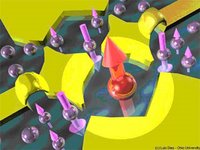Nano News: Double Quantum Dots Control Kondo Effect, Thursday Sep 14, 2006 by ANDREA GIBSON
 | Nanoscale metallic electrodes (in yellow) can be used to confine electrons in small regions, forming quantum dots. Two quantum dots connected to each other form a double quantum dot. |
ATHENS, Ohio — Two quantum dots connected by wires could help scientists better control the Kondo effect in experiments, according to a study by Ohio University and University of Florida physicists published in a recent issue of Physical Review Letters.
The Kondo effect occurs when electrons become trapped around the magnetic impurities in semiconductor materials, which prompts the electrons to change their spin. This phenomenon has intrigued scientists, as electronic correlations can create interesting and complex behavior in materials.
src="http://pagead2.googlesyndication.com/pagead/show_ads.js">
In the new work, scientists demonstrate how the two quantum dot system can behave in two different and interesting ways: As a simile for a Kondo-effect system where one quantum dot is used to "filter" the effect of the current leads, and as a way to study "pseudo-gapped" systems and correlations in them, which can help scientists understand structures such as superconductors.
“This last part is of great current interest to theorists and experimentalists who are exploring what are called quantum phase transitions, which are changes in systems that alter their behavior dramatically as a function of some parameter while remaining at zero (or very low) temperature,” said Sergio Ulloa, a professor of physics and astronomy at Ohio University.
The study, funded by the National Science Foundation, was conducted by Luis Dias da Silva, Nancy Sandler and Ulloa, all members of the Ohio University’s Nanoscale and Quantum Phenomena Institute, and Kevin Ingersent of the University of Florida.
Technorati Tags: nanofibers or Nanoscientists and Nano or Nanotechnology and nanoparticles or Nanotech and Double Quantum Dots or nanochemistry and nanoscale or nanowires and Nanocantilevers or nanometrology and Kondo Effect or Nanolight and nanostructures or Nanoscience
RELATED: Keywords Nanotech, science Saturday, September 16, 2006 Biodegradable napkin, featuring nanofibers, may detect biohazards, Friday, September 08, 2006 Nanoscientists Create Biological Switch from Spinach Molecule, Sunday, September 03, 2006 Sugar metabolism tracked in living plant tissues, in real time, Wednesday, August 30, 2006 'Nanocantilevers' yield surprises critical for designing new detectors, Sunday, August 27, 2006 ion pump cooling hot computer chips, Thursday, August 24, 2006 Honeycomb Network Comprised of Anthraquinone Molecules, Sunday, August 20, 2006 siRNA shrink ovarian cancer tumors, Wednesday, August 16, 2006 Nanotechnology














No comments:
Post a Comment